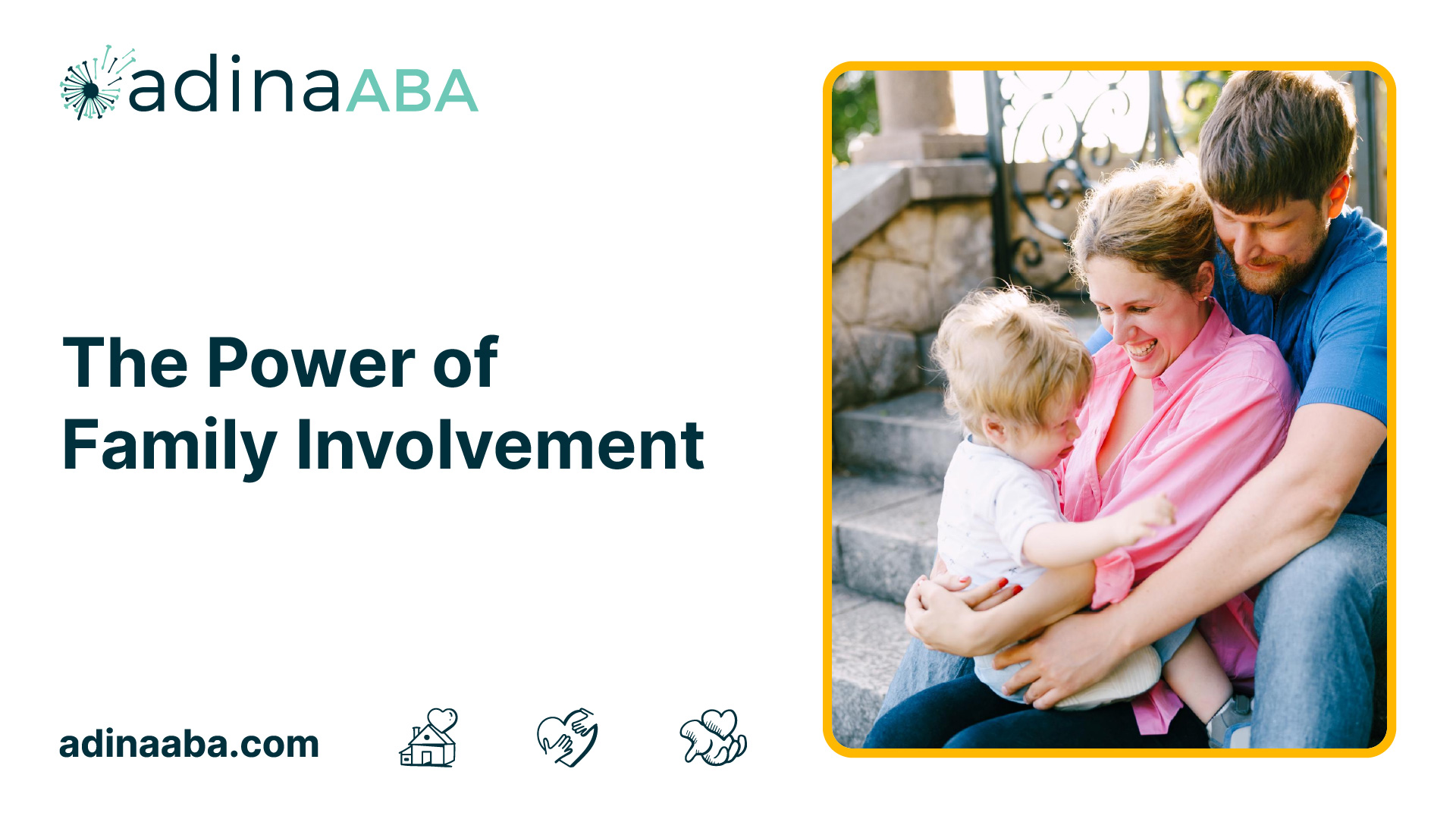Top 5 Benefits of In-Home ABA Therapy
.jpg)

Understanding ABA Therapy
ABA Therapy, or Applied Behavior Analysis Therapy, is a scientifically proven approach to understanding and modifying behavior. It is widely recognized as an effective intervention for individuals with developmental and behavioral challenges. This section will explore what ABA therapy is, the benefits it offers, and the importance of consistency in its implementation.
What is ABA Therapy?
ABA Therapy is a systematic and evidence-based approach that utilizes the principles of behavior analysis to improve socially significant behaviors. It focuses on understanding the relationship between behavior and the environment in which it occurs. ABA therapists work closely with individuals to identify specific behaviors and develop strategies to promote positive changes.
Through careful observation and data analysis, ABA therapists assess behaviors, identify triggers, and implement interventions to address a wide range of skills and challenges. These can include language and communication, social skills, self-care, academic skills, and more. ABA therapy is highly individualized, allowing for personalized treatment plans tailored to each person's unique needs.
Benefits of ABA Therapy
ABA therapy offers numerous benefits for individuals receiving treatment. Some of the key advantages include:
- Skill development: ABA therapy focuses on building and strengthening a wide range of skills, including academic, social, and daily living skills. It helps individuals develop functional and adaptive behaviors that can enhance their quality of life.
- Behavior reduction: ABA therapy can effectively reduce problem behaviors by identifying their underlying causes and implementing targeted interventions. It aims to replace challenging behaviors with more appropriate alternatives.
- Generalization of skills: ABA therapy emphasizes the generalization of skills, teaching individuals to apply what they have learned in various environments and situations. This promotes the transfer of skills from therapy sessions to real-life settings.
- Promotion of independence: ABA therapy empowers individuals to become more independent and self-reliant. It focuses on teaching skills that promote self-care, problem-solving, decision-making, and self-advocacy.
- Collaboration and support: ABA therapy involves collaboration between therapists, families, and other professionals involved in the individual's care. This collaborative approach ensures a comprehensive and consistent support system for the individual.
Importance of Consistency
Consistency is a fundamental aspect of ABA therapy. It plays a crucial role in achieving optimal outcomes for individuals receiving treatment. Consistency refers to the regular and systematic implementation of interventions and strategies across different environments and individuals involved in the person's life.
By maintaining consistency in implementing ABA techniques and strategies, individuals can experience more predictable and reliable outcomes. Consistency helps create a structured and supportive environment that enhances learning and behavior change. It allows individuals to understand and generalize the skills they learn during therapy sessions to their everyday lives.
Consistency is not only essential during therapy sessions but should also extend to the individual's home, school, and community settings. Collaboration between therapists, families, and other caregivers is vital to ensure that consistent approaches are used across different environments and in various social interactions.
In summary, ABA therapy is a highly effective intervention that focuses on behavior modification and skill development. Its benefits include skill acquisition, behavior reduction, generalization of skills, promotion of independence, and collaborative support. Consistency in implementing ABA techniques is crucial for maximizing the effectiveness of therapy and promoting positive outcomes for individuals receiving treatment.
In-Home ABA Therapy
ABA therapy, or Applied Behavior Analysis therapy, is a widely recognized and effective treatment approach for individuals with autism spectrum disorder (ASD). In-home ABA therapy brings the benefits of ABA therapy directly to the comfort and convenience of the individual's home environment. This section will provide an overview of in-home ABA therapy, highlight its advantages, and emphasize the importance of tailoring treatment to individual needs.
Overview of In-Home ABA Therapy
In-home ABA therapy involves the delivery of ABA-based interventions in the individual's home setting. A qualified ABA therapist works closely with the individual, their family, and other caregivers to implement behavior programs designed to target specific skill acquisition and behavior reduction goals. The therapist conducts assessments, develops individualized treatment plans, and delivers therapy sessions in the familiar surroundings of the individual's home.
Advantages of In-Home ABA Therapy
In-home ABA therapy offers several advantages over center-based therapy. By providing therapy in the home, it allows for a more personalized and natural learning environment. Some of the key advantages of in-home ABA therapy include:
- Comfort and Familiarity: The home environment offers a sense of comfort, familiarity, and security for the individual receiving therapy. This can help reduce anxiety and increase engagement in the therapy process.
- Generalization of Skills: In-home therapy allows for the direct application of learned skills within the individual's natural environment. This promotes the generalization of skills and behaviors across various settings and situations.
- Family Involvement: In-home therapy encourages active involvement of family members and caregivers. This involvement enhances learning opportunities and facilitates the transfer of skills to everyday life.
- Flexibility: In-home therapy offers greater flexibility in scheduling therapy sessions, making it easier to accommodate the individual's and family's daily routines and commitments.
Tailoring Treatment to Individual Needs
One of the significant benefits of in-home ABA therapy is the ability to tailor treatment to the individual's unique needs. A qualified ABA therapist conducts thorough assessments to identify the individual's strengths, challenges, and specific goals. Based on these assessments, an individualized treatment plan is developed, targeting specific areas such as communication, social skills, self-care, and behavior management.
Through in-home ABA therapy, the therapist can observe the individual in their natural environment and gain a deeper understanding of their unique needs and challenges. This allows for the customization of therapy techniques, strategies, and interventions to maximize progress and outcomes.
By bringing therapy directly into the home, in-home ABA therapy provides a highly individualized and effective approach to help individuals with ASD reach their full potential. The personalized nature of this therapy, coupled with the advantages it offers, makes it a valuable option for families seeking comprehensive support and guidance in the treatment of autism.
The Power of Family Involvement

When it comes to ABA therapy, the involvement of the family plays a crucial role in the success of the treatment. Family members are not just passive observers but active participants in the therapy process. In this section, we will explore the role of the family in ABA therapy, the importance of creating a supportive environment, and how collaboration can enhance progress.
Role of Family in ABA Therapy
The family plays a significant role in ABA therapy. They are the primary caregivers and have the most consistent interactions with the individual receiving therapy. By actively participating in the therapy sessions and implementing strategies learned from therapists, family members can reinforce the skills and behaviors targeted in therapy.
Family involvement also extends beyond the therapy sessions. Consistency and generalization of skills are critical for successful outcomes. By incorporating ABA strategies into daily routines and activities, the family can create an environment that supports and reinforces the progress made during therapy.
Creating a Supportive Environment
Creating a supportive environment is essential for the success of ABA therapy. This involves establishing a structured and predictable routine, providing clear expectations, and setting up the physical environment to facilitate learning and positive behaviors.
A structured routine helps individuals with autism thrive by providing a sense of security and predictability. Consistency in daily activities and expectations allows for the reinforcement of desired behaviors and reduces anxiety. By following a consistent routine, family members can create a supportive environment that promotes learning and generalization of skills.
Enhancing Progress Through Collaboration
Collaboration between the family and ABA therapists is key to enhancing progress. ABA therapists bring their expertise and knowledge, while family members offer their unique understanding of the individual and their preferences. By sharing information and working together, therapists and families can develop effective strategies tailored to the individual's needs.
Regular communication between therapists and family members is crucial for maintaining consistency and addressing any concerns or questions. This collaboration ensures that the therapy goals are aligned and that progress is being made both in therapy sessions and in the home environment.
Ways to Enhance Collaboration
- Regular meetings with therapists
- Sharing observations and progress
- Discussing strategies and modifications
- Implementing therapist recommendations
By actively involving the family in ABA therapy, creating a supportive environment, and promoting collaboration, individuals with autism can experience greater progress and success. The power of family involvement cannot be underestimated in the journey towards positive outcomes and improved quality of life.
Setting Up for Success
To ensure a successful in-home ABA therapy experience, it's essential to create a structured environment, establish clear communication, and implement positive reinforcement techniques. These elements play a crucial role in optimizing the effectiveness of therapy sessions and promoting progress.
Creating a Structured Environment
Creating a structured environment is vital for in-home ABA therapy. Structure provides predictability and consistency, which are essential for individuals undergoing therapy. Here are key elements to consider when establishing a structured environment:
- Clear Routine: Establishing a consistent daily routine helps individuals with autism feel secure and understand what to expect. Having a visual schedule or timetable can be beneficial in providing clear structure and reducing anxiety.
- Organized Space: Ensure the therapy space is organized and free from distractions. This helps individuals focus on therapy activities and minimizes unnecessary sensory stimulation that may hinder progress.
- Visual Supports: Visual supports, such as visual schedules, task lists, and visual cues, can assist individuals in understanding and following instructions. These visual aids provide clear and concise information, promoting independence and reducing reliance on verbal prompts.
Establishing Clear Communication
Clear communication is key to effective in-home ABA therapy. Open and transparent communication between therapists, family members, and the individual receiving therapy ensures that everyone is on the same page. Consider the following aspects of establishing clear communication:
- Consistent Communication Channels: Establish consistent communication channels, such as regular meetings, emails, or a communication notebook, to exchange information and discuss progress, concerns, and updates.
- Shared Goals: Collaborate with the therapy team to set clear goals for the individual receiving therapy. Ensure that everyone involved understands the objectives and works collectively towards achieving them.
- Open Dialogue: Encourage open and honest communication to address any challenges or questions that may arise during the therapy process. This allows for timely adjustments and ensures that the therapy stays aligned with the individual's needs.
Implementing Positive Reinforcement
Positive reinforcement is a fundamental component of ABA therapy. It involves providing rewards or praise to reinforce desired behaviors and motivate individuals to continue engaging in those behaviors. Here are some key points to consider when implementing positive reinforcement:
- Identify Reinforcers: Determine what motivates the individual receiving therapy. This could be a favorite toy, access to preferred activities, or verbal praise. By understanding their preferences, you can tailor the reinforcement strategy to be effective.
- Immediate Reinforcement: Provide reinforcement immediately after the desired behavior occurs. This helps strengthen the connection between the behavior and the reward, making it more likely for the behavior to be repeated.
- Consistency and Variety: Maintain consistency in reinforcing desired behaviors, but also introduce variety to prevent the reinforcement from losing its effectiveness over time. This can involve using a range of reinforcers or adjusting the schedule of reinforcement.
By creating a structured environment, establishing clear communication, and implementing positive reinforcement techniques, you can set the stage for success in in-home ABA therapy. These strategies provide a solid foundation for progress and promote a positive therapeutic experience for individuals with autism and their families.
Progress Monitoring and Adjustments
Tracking the progress of a child receiving in-home ABA therapy is a crucial aspect of ensuring the effectiveness of the treatment. Regular monitoring allows for the identification of milestones achieved and areas that may require adjustments. Celebrating achievements and successes along the way motivates both the child and the therapy team to continue making strides.
Tracking Progress and Milestones
In-home ABA therapy involves the systematic application of behavioral strategies to target specific goals. Measuring progress is vital to assess the child's development and determine the effectiveness of the therapy. Here are some ways progress can be tracked:
Regularly tracking progress and milestones provides valuable information for the therapy team to make informed decisions about adjustments and modifications in the treatment plan.
Making Necessary Adjustments
In-home ABA therapy is a dynamic process that requires flexibility and the ability to adapt to the child's changing needs. As progress is monitored, adjustments to the treatment plan may be necessary to ensure continued progress. Some reasons adjustments may be made include:
- Changes in the child's behavior or skill acquisition patterns.
- Feedback from the family regarding the child's response to therapy.
- New goals or targets identified as priorities for the child's development.
The therapy team, in collaboration with the family, will evaluate the child's progress and make any necessary adjustments to the treatment plan. This may involve modifying strategies, introducing new techniques, or refining existing interventions to better meet the child's needs.
Celebrating Achievements and Successes
Recognizing and celebrating achievements and successes is an essential part of the in-home ABA therapy journey. It not only acknowledges the child's progress but also provides motivation and reinforcement for continued growth. Celebrations can take various forms, including verbal praise, high-fives, small rewards, or special activities that the child enjoys.
By celebrating achievements, the child develops a positive association with therapy sessions and a sense of accomplishment. It also fosters a supportive and encouraging environment that promotes further progress.
In-home ABA therapy is a collaborative effort, and progress monitoring, making necessary adjustments, and celebrating achievements are integral components of this process. By closely monitoring progress, making adjustments as needed, and recognizing successes, in-home ABA therapy can maximize the child's developmental gains and overall well-being.
Considering In-Home ABA Therapy

In-home ABA therapy can be a valuable option for families seeking autism treatment for their loved ones. Before deciding if in-home ABA therapy is right for your family, it's important to consider a few key factors. Additionally, finding qualified professionals and understanding the continuation of progress beyond therapy sessions are crucial aspects to keep in mind.
Is In-Home ABA Therapy Right for Your Family?
Determining if in-home ABA therapy is the best fit for your family requires careful consideration. Here are some factors to think about:
- Convenience: In-home ABA therapy offers the convenience of receiving therapy sessions in the comfort of your own home. This eliminates the need for travel and can be particularly beneficial for individuals who may struggle with transitions or unfamiliar environments.
- Individualized Attention: In-home therapy allows for one-on-one attention, as the focus is solely on your child and their specific needs. The therapist can customize the treatment plan to address your child's unique strengths and challenges.
- Family Involvement: In-home ABA therapy provides opportunities for family members to actively participate in the therapy process. This involvement can help reinforce skills learned during therapy sessions and promote generalization of those skills to other settings.
- Availability of Resources: Consider the availability of necessary resources in your home environment. Ensure that you have an appropriate space for therapy sessions and access to any materials or equipment that may be required.
Finding Qualified Professionals
When considering in-home ABA therapy, it's essential to find qualified professionals who are experienced in providing this type of therapy. Here are some steps to help you in your search:
- Research: Begin by researching local ABA therapy providers or organizations that offer in-home services. Look for professionals with the necessary qualifications, such as Board Certified Behavior Analysts (BCBAs) or Registered Behavior Technicians (RBTs).
- Credentials and Experience: Review the credentials and experience of potential therapists. Consider their expertise in working with individuals with autism and their ability to tailor treatment to meet your child's specific needs.
- References and Reviews: Request references or read online reviews to gather feedback from other families who have utilized the services of the professionals you are considering. This can provide valuable insights into the quality of care they provide.
Continuation of Progress Beyond Therapy Sessions
In-home ABA therapy is just one component of a comprehensive treatment plan for individuals with autism. To ensure continued progress, it's important to consider the following:
- Generalization of Skills: Work with the therapist to develop strategies for generalizing the skills learned during therapy sessions to other environments, such as school, community settings, and social interactions.
- Collaboration with Schools and Other Professionals: Foster open communication and collaboration between the ABA therapist, school staff, and any other professionals involved in your child's care. This collaborative approach helps ensure consistency and promotes the transfer of skills across different settings.
- Parent Training and Support: Seek out opportunities for parent training and support to enhance your understanding of ABA techniques and strategies. This empowers you to reinforce learned skills and continue progress outside of therapy sessions.
By carefully considering the suitability of in-home ABA therapy for your family, finding qualified professionals, and understanding how to continue progress beyond therapy sessions, you can make an informed decision that supports your child's growth and development.
Sources
https://tbh.com/a-parents-guide-to-in-home-aba-therapy
https://www.bluesprigautism.com/what-to-expect-from-in-home-aba-therapy
https://www.sbsaba.com/the-complete-guide-to-in-home-aba-therapy
https://www.stepstoprogress.com/aba-therapy/what-is-in-home-aba-therapy
More Resources
Expert Clinicians
Get started today ->



.jpg)
.jpg)

.jpg)